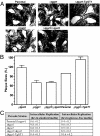Host-derived glucose and its transporter in the obligate intracellular pathogen Toxoplasma gondii are dispensable by glutaminolysis
- PMID: 19617561
- PMCID: PMC2722337
- DOI: 10.1073/pnas.0903831106
Host-derived glucose and its transporter in the obligate intracellular pathogen Toxoplasma gondii are dispensable by glutaminolysis
Abstract
Toxoplasma gondii, as an obligate intracellular and promiscuous pathogen of mammalian cells, utilizes host sugars for energy and to generate glycoconjugates that are important to its survival and virulence. Here, we report that T. gondii glucose transporter (TgGT1) is proficient in transporting mannose, galactose, and fructose besides glucose, and serves as a major hexose transporter at its plasma membrane. Toxoplasma harbors 3 additional putative sugar transporters (TgST1-3), of which TgST2 is expressed at its surface, whereas TgST1 and TgST3 are intracellular. Surprisingly, TgGT1 and TgST2 are nonessential to the parasite as their ablations inflict only a 30% or no defect in its intracellular growth, respectively. Indeed, Toxoplasma can also tolerate the deletion of both genes while incurring no further growth phenotype. Unlike Deltatgst2, the modest impairment in Deltatggt1 and Deltatggt1/Deltatgst2 mutants is because of a minor delay in their intracellular replication, which is a direct consequence of the abolished import of glucose. The Deltatggt1 displays an attenuated motility in defined minimal media that is rescued by glutamine. TgGT1-complemented parasites show an entirely restored growth, motility, and sugar import. The lack of exogenous glucose in Deltatggt1 culture fails to accentuate its intrinsic growth defect and prompts it to procure glutamine to sustain its metabolism. Unexpectedly, in vivo virulence of Deltatggt1 in mice remains unaffected. Taken together, our data demonstrate that glucose is nonessential for T. gondii tachyzoites, underscore glutamine is a complement substrate, and provide a basis for understanding the adaptation of T. gondii to diverse host cells.
Conflict of interest statement
The authors declare no conflict of interest.
Figures





References
Publication types
MeSH terms
Substances
Associated data
- Actions
- Actions
- Actions
LinkOut - more resources
Full Text Sources
Other Literature Sources

